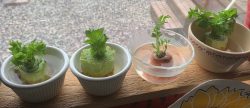Pips are an easy way to grow vegetables. Most folks throw away the carrot tops, lettuce and cabbage butts, celery ends, and potatoes ends. All these vegetables make for great Pips! If you have a portion of the vegetable, you don’t need seeds to start over. This cuts a lot of growing time off the harvest.
Years ago, I worked as a chef at a fishing and hunting camp. We often used fresh salads. I saved the Pips and stashed them in a nearby wetland area. To protect them, I built a rustic branch pile over top them to keep them away from the grazers. I also made a pool where I grew watercress. Further down the wetland was a huge rockpile where I dug a hole to make a rustic cold box. Only vegetables wet into this stash.
Each time I had Pips, I added to my garden in the meadow. When Archery season came in for Elk, I had fully grown celery, romaine, iceberg, carrots, and several large zucchinis. When I went shopping in my garden, the campers were really impressed at my fresh harvest.
With food in short supply, and a short Montana growing season, gardeners need all the help they can get to grow fresh vegetables.
To make a Pip, leave an inch or two of the top or butt of the plant. Pips always need to be wet. In my kitchen, I place the Pips into small dishes until they grow a few inches tall. Once they get a good growing head start, I transplant them into the garden. I find that they do best in shadier parts of the garden where the ground stays moist.
To keep water on the plants, I shove a bottomless plastic bottle next to the plant. A narrow stick shoved through the bottle spout keeps them in place. I also add a couple small rocks into the Plant Funnel to slow the flow. You want the Pips damp, but not swimming.
You can also cut a sweet potato in half and grow a huge decorative vine over and across your window. Remember that your sprouting potatoes are seeds trying to grow. Take a small trash can and remove the bottom. Bury ¾ of the bucket into the ground. Fill with loose soil and plant the potatoes. I also use the funnels to keep things irrigated. In the end of the season, simply pull the bucket up and watch your tates fall free. A 25-35-gallon can will grow almost 50 nice sized tates!
Recycling foods is a great way to creatively save money and grow food fresh!
Just like the Gardener and the Pips!
Montana Grant
For more Montana Grant, find his green thumb at www.montanagrantfishing.com.